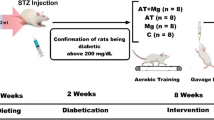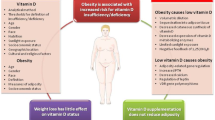Abstract
Aim
Several chronic metabolic alterations are present in obese subjects. While it is well known about the detrimental effect of abdominal adipose tissue on chronic metabolic clinical condition, less is known on the role of lean mass in obese subjects. Thus, the aim of our study was to evaluate the potential correlation of muscle mass, metabolic condition and inflammation status in obese individuals.
Methods
The study included 426 obese subjects (86 men and 340 female; mean age 44.8 ± 14 years; BMI: 34.9 ± 6.1 kg/m2). Exclusion criteria were chronic medical conditions or use of medications affecting bone metabolism, alterations of hormonal and nutritional status, vitamin D supplementation, recent weight loss and prior bariatric surgery. Patients underwent measurements of bone mineral density (lumbar and hip) and body composition (lean mass, total and trunk fat mass) by dual X-ray absorptiometry and were evaluated for hormonal and metabolic profile and inflammatory markers.
Results
Higher lean body mass (LM%) was inversely correlated with homeostasis model assessment of insulin resistance (p < 0.0091; r 2 0.03938) and associated with lower fibrinogen levels (p < 0.0001; r 2 0.1263). Interestingly, in obese subjects, LM% was associated with higher levels of vitamin D (p < 0.0001, r 2 0.1140), osteocalcin (p < 0.0001, r 2 0.2401) and insulin-like growth factor-1 (IGF-1) (p < 0.0002, r 2 0.1367).
Conclusion
Our results show for the first time that in obese patients, higher amounts of lean mass are directly linked to a lower inflammatory profile and to better insulin sensitivity, but also to the presence of higher level of vitamin D and IGF-1. Moreover, these data suggest that higher levels of lean mass in obese people correlate with a better metabolic profile and, thus, strongly suggest the need to develop programs to facilitate an increase in physical activity in obese people.



Similar content being viewed by others
References
Hu FB (2003) Overweight and obesity in women: health risk and consequences. J Women Health (Larchmt) 12:163–170
World Health Organisation (2012). http://www.who.int/topics/obesity/en/. Accessed 11 Feb 2012
Gilsanz V, Chalfant J, Mo AO, Lee DC, Dorey FJ, Mittelman SD (2009) Reciprocal relations of subcutaneous and visceral fat to bone structure and strength. J Clin Endocrinol Metab 94:3387–3393
Cruz-Jentoft AJ, Baeyens JP, Bauer JM et al (2010) Sarcopenia: European consensus on definition and diagnosis. Age Ageing 39:412–423
Migliaccio S, Greco EA, Wannenes F, Donini LM, Lenzi A (2014) Adipose, bone and muscle tissues as new endocrine organs: role of reciprocal regulation for osteoporosis and obesity development. Horm Mol Biol Clin Invest 17:39–51
Carnevale V, Romagnoli E, Del Fiacco R, Pepe J, Cipriani C, Piemonte S et al (2010) Relationship between bone metabolism and adipogenesis. J Endocrinol Invest 33:4–8
Rosen CJ, Bouxsein ML (2006) Mechanisms of disease: is osteoporosis the obesity of bone? Nat Clin Pract Rheumatol 2:35–43
Takada I, Suzawa M, Matsumoto K, Kato S (2007) Suppression of PPAR transactivation switches cell fate of bone marrow stem cells from adipocytes into osteoblasts. Ann N Y Acad Sci 1116:182–195
Rosen CJ (2008) Bone remodeling, energy metabolism, and the molecular clock. Cell Metab 7:7–10
Vikman K, Isgaard J, Edén S (1991) Growth hormone regulation of insulin-like growth factor-1 mRNA in rat adipose tissue and isolated rat adipocytes. J Endocrinol 131:139–145
Ohlsson C, Bengtsson BA, Isaksson OG, Andreassen TT, Slootweg MC (1998) Growth hormone and bone. Endocr Rev 19:55–79
Liu G, Lu L, Sun Q, Ye X, Sun L, Liu X et al (2014) Poor vitamin D status is prospectively associated with greater muscle mass loss in middle-aged and elderly Chinese individuals. J Acad Nutr Diet S2212–2672(14):00597–00598
Greco EA, Fornari R, Rossi F, Santiemma V, Prossomariti G, Annoscia C et al (2010) Is obesity protective for osteoporosis? Evaluation of bone mineral density in individuals with high body mass index. Int J Clin Pract 64:817–820
Toledo-Corral CM, Roberts CK, Goran MI (2008) Insulin-like growth factor-1 is inversely related to adiposity in overweight Latino children. J Pediatr Endocrinol Metab 21:855–864
Alderete TL, Byrd-Williams CE et al (2011) Relationships between IGF-I and IGFBP-I and adiposity in obese African American and Latino adolescents. Obesity 19:933–938
Galli G, Pinchera A, Piaggi P, Fierabracci P, Giannetti M et al (2012) Serum insulin-like growth factor-1 concentrations are reduced in severely obese women and raise after weight loss induced by laparoscopic adjustable gastric banding. Obes Surg 22:1276–1280
Clasey JL, Weltman A, Patrie J, Weltman JY, Pezzoli S, Bouchard C et al (2001) Abdominal visceral fat and fasting insulin are important predictors of 24-hour GH release independent of age, gender, and other physiological factors. J Clin Endocrinol Metab 86:3845–3852
Utz AL, Yamamoto A, Sluss P, Breu J, Miller KK (2008) Androgens may mediate a relative preservation of IGF-1 levels in overweight and obese women despite reduced growth hormone secretion. J Clin Endocrinol Metab 93:4033–4040
Migliaccio S, Francomano D, Bruzziches R, Greco EA, Fornari R, Donini LM et al (2013) Trunk fat negatively influences skeletal and testicular functions in obese men: clinical implications for the aging male. Int J Endocrinol. doi:10.1155/2013/182753 (Epub 2013 Nov 20)
Lucey AJ, Paschos GK, Thorsdottir I, Martínéz JA, Cashman KD, Kiely M (2013) Young overweight and obese women with lower circulating osteocalcin concentrations exhibit higher insulin resistance and concentrations of C-reactive protein. Nutr Res 33:67–75
Francomano D, Lenzi A, Aversa A (2014) Effects of 5-year treatment with testosterone undecanoate on metabolic and hormonal parameters in ageing men with metabolic syndrome. Int J Endocrinol 2014:527470. doi:10.1155/2014/527470 (Epub 2014 Feb 12)
Gerdhem P, Ringsberg KA, Obrant KJ, Akesson K (2005) Association between 25-hydroxy vitamin D levels, physical activity, muscle strength and fractures in the prospective population-based OPRA study of elderly women. Osteoporos Int 16:1425–1431
Houston DK, Cesari M, Ferrucci L, Cherubini A, Maggio D, Bartali B et al (2007) Association between vitamin D status and physical performance: the InCHIANTI study. J Gerontol 62:440–446
Kim MK, Baek KH, Song KH, Kang M, Park CY, Lee WY et al (2011) Vitamin D deficiency is associated with sarcopenia in older Koreans, regardless of obesity: the Fourth Korea National Health and Nutrition Examination Surveys (KNHANES IV) 2009. J Clin Endocrinol Metab 96:3250–3256
Bischoff HA, Borchers M, Gudat F, Duermueller U, Theiler R, Stahelin HB et al (2001) In situ detection of 1,25-dihydroxyvitamin D3 receptor in human skeletal muscle tissue. Histochem J 33:19–24
Simpson RU, Thomas GA, Arnold AJ (1985) Identification of 1,25-dihydroxyvitamin D3 receptors and activities in muscle. J Biol Chem 260:8882–8891
Park S, Ham JO, Lee BK (2014) A positive association of vitamin D deficiency and sarcopenia in 50 year old women, but not men. Clin Nutr 33:900–905
Dawson-Hughes B (2008) Serum 25-hydroxyvitamin D and functional outcomes in the elderly. Am J Clin Nutr 88:537–540 (Research Support, U.S. Government, Non-P.H.S. review)
Fielding RA, Vellas B, Evans WJ, Bhasin S, Morlei JE, Newmnan AB et al (2011) Sarcopenia: an undiagnosed condition in older adults. Current consensus definition: prevalence, etiology and consequences. International working group on sarcopenia. J Am Med Dir Assoc 12:249–256
Beyer I, Mets T, Bautmans I (2012) Chronic low-grade inflammation and age-related sarcopenia. Curr Opin Clin Nutr Metab Care 15:12–22
Kim TN, Park MS, Lim KI, Choi HY, Yang SJ, Yoo HJ et al (2013) Relationships between sarcopenic obesity and insulin resistance, inflammation, and vitamin D status: the Korean Sarcopenic Obesity Study. Clin Endocrinol 78:525–532
Gonnelli S, Caffarelli C, Tanzilli L, Alessi C, Tomai Pitinca MD et al (2013) The associations of body composition and fat distribution with bone mineral density in elderly Italian men and women. J Clin Densitom 16:168–177
Acknowledgments
Research was funded by PRIN 2009—2009KENS9K_004 to LMD; PRIN 2011 052013 to SM, PON 01_00829 to AL, PRIN Muskendo. LiSa laboratories are a Joint-Venture between Eli Lilly Firenze and Sapienza University of Rome, Department of Experimental Medicine, Section of Medical Pathophysiology, Endocrinology and Nutrition, Sapienza University of Rome.
Conflict of interest
The authors declare that there is no conflict of interest that could prejudice the impartiality of the research reported. FW was supported by an ELI Lilly grant. AA, EAG, VBM are supported by PON 01_00829.
Author information
Authors and Affiliations
Corresponding author
Additional information
R. Fornari and D. Francomano equally contributed to this work.
Rights and permissions
About this article
Cite this article
Fornari, R., Francomano, D., Greco, E.A. et al. Lean mass in obese adult subjects correlates with higher levels of vitamin D, insulin sensitivity and lower inflammation. J Endocrinol Invest 38, 367–372 (2015). https://doi.org/10.1007/s40618-014-0189-z
Received:
Accepted:
Published:
Issue Date:
DOI: https://doi.org/10.1007/s40618-014-0189-z




